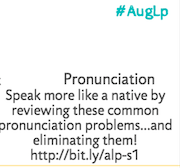
Common Pronunciation Issues…Eliminated!
Happy Thursday to you!
We are nearly finished with Week 2 of our August Learning Plan, and our focus all week has been on improving our speaking skills! If this is your first time on English Outside the Box’s learning blog, first of all, WELCOME! I am happy to have you join me! Next, I encourage you to stop reading and click here, to have a quick review of what this August Learning Plan is all about. That click will bring you over to my YouTube channel to practice listening comprehension and hear what this plan is; if you prefer to read, then click the link the first sentence!
If you are a little late on this week’s activities, don’t worry! You have heard the expression, it’s better late than never, right? So you can just start now! You still have an opportunity to join my Group Conversation class, for FREE this week on Saturday, just use the coupon code ALP before you select your time zone and sign-up. Tuesday was a blast, so I hope you can join us this Saturday. (*note: group conversation classes for this learning plan have expired*)
You can still participate in the Instagram/Facebook/YouTube video challenge, just upload a video on any of those platforms practicing speaking. After you introduce yourself, speak about these two topics: 1)talking about your next vacation and 2) something you learned last week. These simple tasks will get you practice with using the simple present, future, and past tenses. Make sure to tag me (@jenesl760) and use the hashtag #auglp so I can see it and give you some feedback. Be sure to check out my video, along with new blog author Isadora……here!
Well, this leads us to today’s post: ELIMINATING PRONUNCIATION ISSUES, and sounding more like a native!
We are going to mainly go over minimal pairs today, and I’ll refer you to some common reductions and modifications in English. For minimal pairs, I’ll review the mouth/tongue position, as this is one of the most important things to remember when making the accurate sounds. Use the video below the text to follow my mouth position as a guide. I am also going to include some of the language groups that have the most difficulty with these sound distinctions, but please note that I cannot possibly review and include all languages, apologies if I didn’t include yours. I tried to represent those that have the highest following on this blog. Thanks for understanding! ♥
Let’s begin….
Common Minimal Pair Issues
Minimal pairs are words that are almost identical, except for 1 differing sound, for example,west and vest. Different languages (and people who speak them) are used to positioning their mouth and tongue in a certain way and may not be comfortable with new sounds that don’t exist in their native language. This is when pronunciation becomes an issue. Minimal pairs create problems when both words could be acceptable in a sentence, and a listener cannot differentiate which one the speaker used.
V vs W (Chinese, Russian, Indian)
The V sound is made by placing your top teeth on the back of your bottom lip, and making a vocalized sound (with the vocal chords, your throat should vibrate!) by blowing air up and through your mouth.
This is different than the W sound which is made by bringing your lips tightly forward (like a kiss!) and vocalizing the sound (with your vocal chords) with the back of your tongue up towards the roof of your mouth.
Minimal Pairs (MPs): vest/west, very/weary, vine/wine, groove/grew, verse/worse
P vs B (Indian, Arabic, Vietnamese)
The P and B sounds are made with the same mouth position, by bringing your lips together and then blowing air through the mouth when opening/parting the lips. The difference is that the P sound is unvoiced (only air passes) and the B is voiced (vocalize with the vocal chords). It’s important to note that these sounds are made in 2 parts (because they’re stop consonants). 1:air comes up and is stopped by the closed mouth and lips, and 2: air released to make the sound when mouth/lips part.
MPs: pear/bear, pat/bat, nap/nab, park/bark, pig/big
L vs R (Korean, Japanese, Chinese)
The L and the R differ in mouth/lip and tongue position, so it’s important to note these and practice, practice, practice!
The L sound is voiced, and is made with slightly open and relaxed lips and teeth, your tongue should be up and just behind the back of your top teeth (your tongue can also come slightly forward, between your teeth).
The R sound is also voiced, but is made with pulling your tongue back, and the mid part of your tongue pushing upward on the roof of your mouth. Your lips come forward, and are tightly round (less tight if the R is at the end of the word). If making the sound accurately, the sound can be held with the air continuously blowing through. Think of a pirate “RRRRRRRR”!
MPs: light/right, load/road, lake/rake, goal/gore, coal/core, leak/reek
B vs V (Spanish, Korean)
The B sound was described above (with the P vs B minimal pairs), so please see above for correct positions.
The V sound was also described above (with the V vs W minimal pairs), so again, please read above.
MPs: best/vest, berry/very, boat/vote, curb/curve, bow/vow
R and H (Portuguese, French, Italian)
The R and the H are difficult for Portuguese speakers because of the different of the “R” sound in Portuguese, it is pronounced like an English “H”, so you can see where this causes confusion.
French and Italian speakers often have difficulties with the H sound whether they vocalize it too much (in American English, we don’t vocalize the “h” in herb, for example), or make the sound when it doesn’t exist (‘I “hate” lunch’ instead of ‘I ate lunch.’)
The R sound is described above (with the L vs R minimal pairs) so please see above for the correct way to make this sound.
The H sound is made by blowing air through your mouth; it is almost a whisper and unvoiced. The position of your lips will vary, depending on the vowel that follows the H in a word; however, if you’re just making the H sound, your mouth is slightly open and relaxed.
MPs: rate/hate, ride/hide, roll/hole, rabbit/habit, red/head, rock/hawk
ending L vs “OH” (Portuguese, Chinese)
These differing ending sounds create problems because they don’t exist in some languages, or are pronounced very differently.
The L sound was explained above, so please see (L vs R) for mouth positions.
The “OH” sound can be described as the way the letter of the alphabet “O” is pronounced, or similarly to the W sound (see above (V vs W).
Non-native speakers need to be careful with their mouth positions, for example: hole (ending with your tongue behind your top teeth) and hoe (end with your lips tightly rounded and your tongue up and back).
MPs: people/pepow*, Brazil/Brazew*, goal/go, able/abow*, mole/mow
*not an actual word
ending -ED sounded (Portuguese, Spanish, Italian)
Words that end in -ED have 3 distinct sounds (“-t” “-d” and “-id”), despite the fact that many ESL learners want to always use the “-id” ending. Make sure you differentiate these three sounds, and are aware that the sound needed depends on the ending sounds of the root verb
Words that end in “T” or “D” are the only words in English that end in the “-id” sound. For example, wanted (wan-tid) and needed (nee-did). See some more verb examples here: https://quizlet.com/_qo7qc
Words that end in a voiced sound, you can feel the vocal chords in your throat vibrate, need to end with the “-d” sound. Most consonants and vowel sounds are voiced, for example, “v” in love, loved (luv-d) or “e” in free, freed (free-d).
Words that end in an unvoiced sound, just air passes through the mouth, have an ending “-t” sound. Some examples are the sound “k” in ask, asked (ask-t), or “s” in pass, passed (pas-t).
Now, review this information, hear the sounds being produced, and see how the mouth/lips/teeth are formed. You may want to follow along with the blog post to read/see what words are being said.
Common Reductions & Modifications
When speaking, English has many sounds that are reduced and modified, as well as words that are connected. Knowing and understanding these reductions, modifications, and combinations will help you speak better, and understand more native speakers in context.
Contractions: combining 2 words together with an apostrophe ‘
Native speakers are lazy, so we’ll find the simple ways to say things why say, “I am” when I can say, “I’m” 🙂 Pay attention in movies, TV, radio, etc.. to the contractions that most native speakers use. Some common contractions are: 1) subject + be: I’m, you’re, he’s, she’s, they’re, we’re 2) subject + will: I’ll, you’ll, he’ll, she’ll, they’ll, we’ll 3) subject + have: I’ve, you’ve, he’s, she’s, they’ve, we’ve 4) auxiliaries + not: do not=don’t, does not=doesn’t, can not=can’t, should not=shouldn’t, would not=wouldn’t, will not=won’t, are not= aren’t,
Reduction of ending “-t” sound: “t” like the “p” and “b” sounds described above are stop consonants, so it is made in 2 parts, 1) stopping the air and 2) releasing the air.
The ending “-t” sound is often not pronounced in American English, which is why the words can and can’t are so hard to differentiate. The tongue will move into the position of the “t” sound (behind the upper front teeth), but it won’t release the air to make it audible; in other words, it’ll complete part of the sound process, but not part 2. Consider the following examples: I am not going (I’m naw-going), Don’t do that (Don-do that). *In both those examples, the tongue should raise to where the T sound is, but not release the air before going onto the next mouth position.
Reduced Sounds: words can differ when said individually or combined into a sentence/longer speech. Let’s review words: and, them, him, her, and can – and see how they sound in text when reduced. Check out this helpful video!
Do you feel like you can speak more confidently now, knowing you won’t make as many mistakes with minimal pairs and can accurately reduce and modify sounds? GOOD! Please share with someone who needs help with English pronunciation, or with someone who might know a learner in need… sharing is caring, after all! ♥ Thanks
Hey! Calling all Portuguese speakers! Você fala português? Melhora sua pronúncia aqui com meu curso: “Pronúncia de inglês para nativos de língua português” ((Do you speak Portuguese? Improve your pronunciation here with my course: “English Pronunciation for Portuguese Speakers”))
Happy Studying!♥
Don’t forget to practice speaking to improve your pronunciation. It’s not enough to just read the text to yourself. You need to be speaking aloud, with a voice, and having real conversations in English to improve your pronunciation and fluency. Get more speaking opportunities and practice here:
The Conversation Club will provide you with 6 group conversation calls to practice with a real teacher and a group message community to connect with other members.
You will also get weekly English lessons to help your vocabulary, listening, reading, pronunciation, and more!
Try the Club for 1 week, free! Join the 1-week free trial here.

Thanks! I’m gonna show some of your tips to my students.
Great André, happy to hear it!